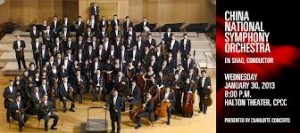It was not so very long ago that a concert tour in the United States was a dream come true for a Chinese orchestral musician – but times have changed.
Indeed, the head of a major Chinese symphony recently told us that just a decade ago his main worry on a US tour was that one or more of his musicians wouldn’t come back to China. Nowadays, he said, laughing, his biggest problem is getting his musicians to agree to go to the US (or Europe) in the first place. They complain, he said, of jet lag, long flights, too little time for fun, language barriers, and accommodations and food that are sub-par compared to China.
So, when a major Chinese symphony tours the US these days, it is not boondoggle, but hard work – as is the case with the ongoing self-proclaimed “commercial tour”(商演) of the China National Symphony Orchestra (CNSO), a 53-day, 30-performance slog that has taken it across sixteen states, mainly by bus. (Upcoming tour dates include March 2, in Ames, Iowa; March 6, in Las Vegas; and March 8, in North Ridge, California.)
The CNSO tour includes a whopping 130 people, among them conductors Li Xincao and Shao En; concertmaster Liu Yunzhi; violin soloists Chen Xi and Li Chuanyun; and pianists Gong Pengpeng and Wu Muye. It is the largest scale tour ever undertaken by an orchestra from China, and also the longest in length with the most performances in the most cities – superlatives that explain why it has been dubbed the “Musical Long March.” The idea for the tour came from Columbia Artists Management, which saw the orchestra perform in Moscow in 2009 and offered to represent it in the US. Columbia initially suggested a 43- city tour, but CNSO management resisted, fearing that would be too much. And indeed, even in the shortened format, Chinese newspaper reports have stressed the exhausting nature of the tour; the “economy hotels on the side of the highway” in which musicians sleep; the winter storms in which the orchestra has been caught; and the endless hours spent on buses – including Chinese New Year’s eve, the most important family holiday of the year.
Sheila caught the CNSO at Duke University earlier this month, where it performed the first movement of orchestra leader Guan Xia’s “Earth Requiem,” a powerful work written in response to the devastating 2008 earthquake in Sichuan; He Zhanhao and Chen Gang’s classic “Butterfly Lovers” violin concerto, performed by Li Chuanyun, who had arrived from China that day; and Beethoven’s “Seventh Symphony.” The orchestra appeared tired – not surprising, since it had spent most of the day travelling by bus from Virginia – but it rallied after the warm welcome given it by a house that was nearly full, despite heavy rain and a home basketball game.
And, indeed, if the tour is commercial in nature, its goals are greater than the bottom line. A tour of this nature enhances the CNSO’s discipline, professionalization, and internationalization. Perhaps more importantly, it supports the political and cultural goal of “letting Chinese symphonic music go out into the world.” Chinese newspapers report that the CNSO has received standing ovations everywhere it goes and that American audiences in second-tier cities appear fascinated by the very existence – not to mention the quality – of a symphonic orchestra from China. The elderly woman seated next to Sheila at the Duke performance had driven two and a half hours to see the concert, and at the end – even facing the drive back home on a miserable night – deemed it more than worthwhile.
“I am never going to get to China,” she said as she stood to applaud. “So if China comes to me – well, that’s just great.”
Next Post: The China National Orchestra US tour


Once you read that the “violin concerto Burtterfly Lovers was a main part of the programme you knew you could not take this so called cultural tour with any serious intent .
“Butterfly Lovers” was only on one program – they have 8 different programs on the tour, which you can see here:
http://www.cami.com/worddocs/worddocs2169/CNSO-PROGRAM-MASTER-PDF-B-H.PDF
They have also programmed violin concertos of Korngold and Sibelius.